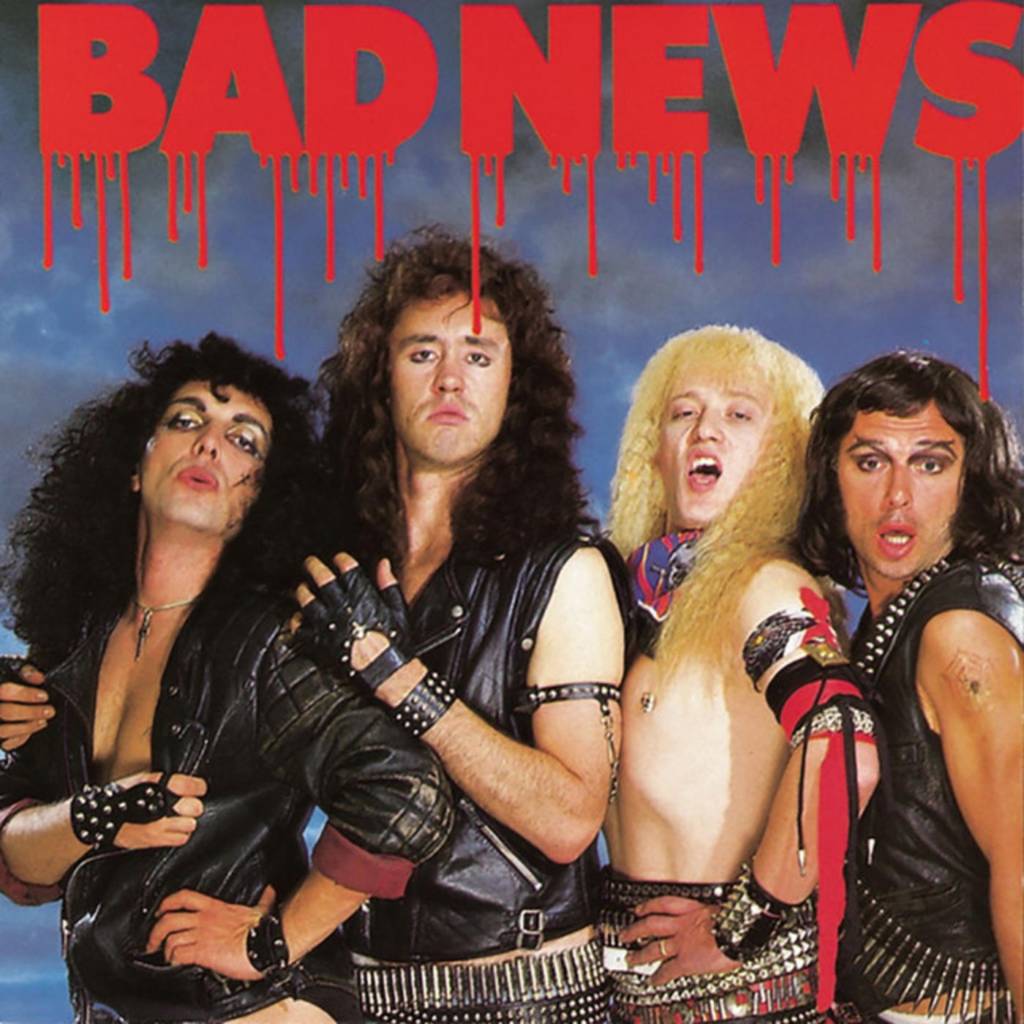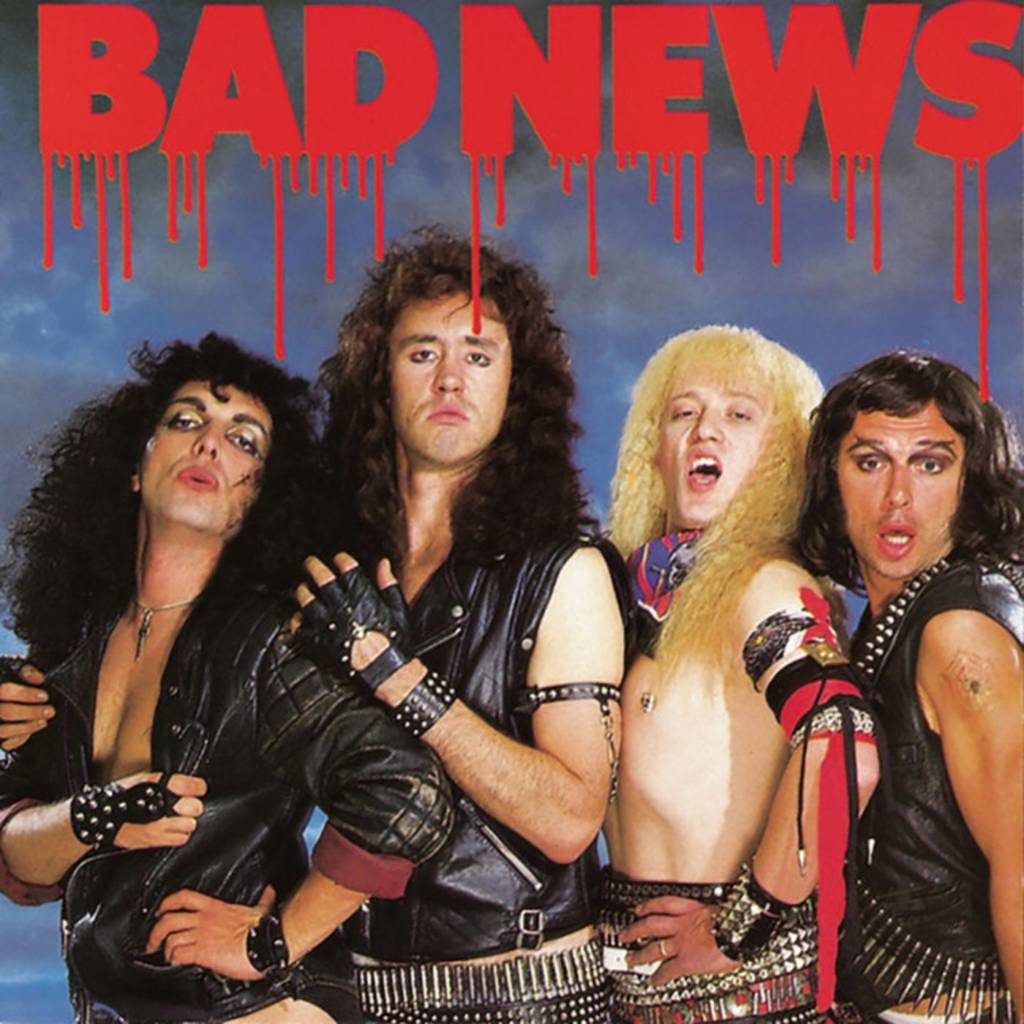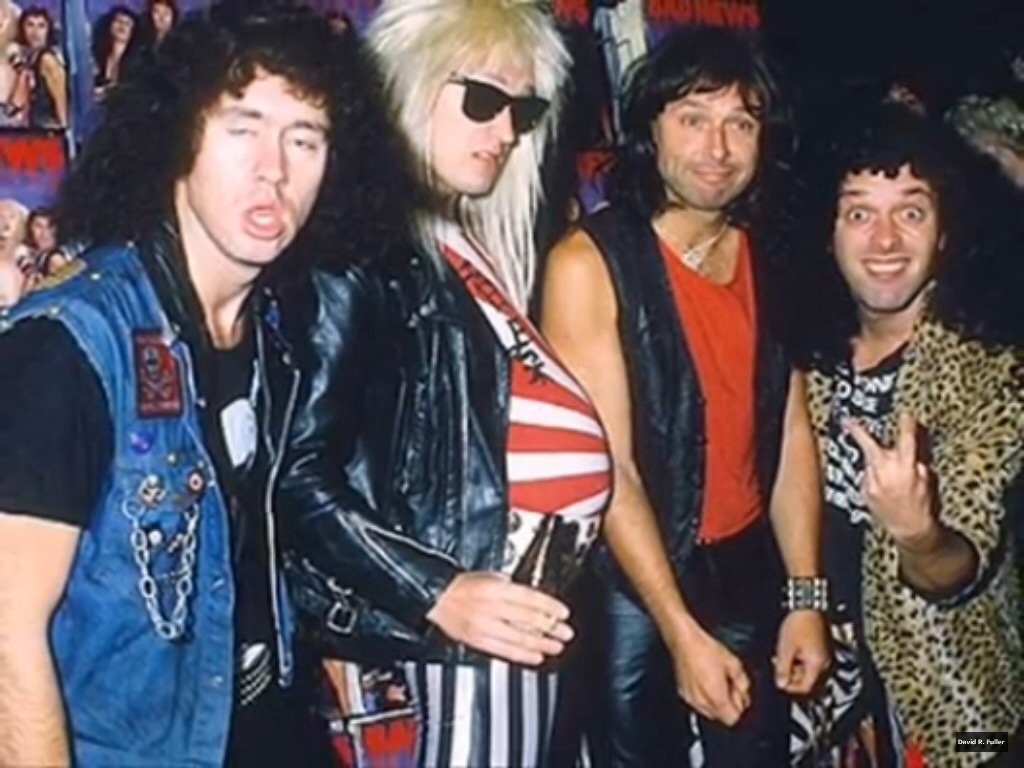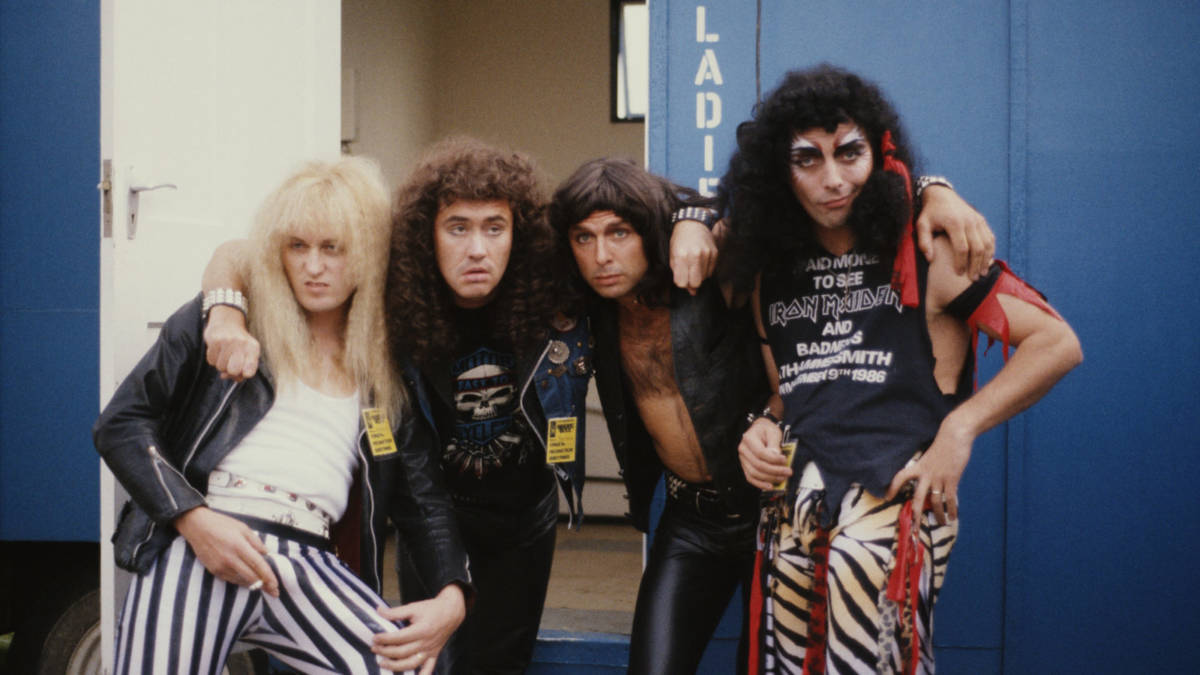Before Spinal Tap, There Was Bad News | Cultured Vultures

Even if you’ve never seen the legendary mockumentary This Is Spinal Tap, you probably know the name – either via the ‘these go to eleven’ sequence, which is by far the most well-remembered part, or otherwise through their appearance in a classic episode of The Simpsons. It’s only appropriate for a show that parodies everything to feature a parody band, and Harry Shearer being in both projects couldn’t have hurt either. As for ‘these go to eleven’, this became iconic enough that many reviews chose to give the film unprecedented ratings of eleven out of ten.
On the surface of it, it could have been taken for a documentary following a real-life rock band – for every obviously absurd moment, like their drummer exploding, there was something realistic enough that a lot of musicians who saw it found it hit far too close to home. Aerosmith’s Steve Tyler apparently “didn’t see any humour in it”, with the section where the band become hopelessly lost backstage really striking a nerve. Dave Grohl was more positive, but agreed in principle, citing This Is Spinal Tap as “the only rock movie worth watching” in contrast to the sea of other rockumentaries out there.
Initially, in fact, it was taken as real by many viewers – drawing a lukewarm reception at the box office, with audiences presumably wondering why they’d never heard of Spinal Tap before, and wondering if the creators had perhaps misspelled Quiet Riot. The film was only saved from the depths of obscurity by its release on home video, allowing the parody to filter through to an audience who understood it, and prompting the cult following it enjoys today.
However, Spinal Tap were by no means the first spoof band. In the ‘70s, Eric Idle and Neil Innes created The Rutles, a bald-faced spoof of The Beatles that George Harrison himself gleefully got involved in, having always been a fan of the Pythons. But in the ‘80s, the year before Spinal Tap burst onto the scene, the British series The Comic Strip Presents… created a mock band that was taking the piss out of the very same era of ultra-glam, ultra-self important, hair-metally bands that Spinal Tap were poking fun at – Bad News.
The Comic Strip Presents… was close to being an anthology series, with each episode self-contained for the most part, although some, such as Bad News and their ‘The Famous Five’ spoof Five Go Mad In Dorset, received second instalments. The people behind it were all centrepieces of the British alternative comedy movement, and many went on to be very well known indeed – comedy duo French and Saunders were central members, and the series often featured Robbie ‘Hagrid’ Coltrane in guest spots. The core group, though, were Peter Richardson, Nigel Planer, Rik Mayall and Adrian Edmondson, the latter three of whom are now perhaps best known from the similarly-anarchic series The Young Ones.
It was these four who made up Bad News, taking on some appropriately rock-style pseudonyms (Edmondson, for instance, was ‘Vim Fuego’) as well as the obligatory outfits, hairspray, and makeup. While they had a very similar aesthetic to the Tap, there were some obvious differences – one, Bad News weren’t as successful, and two, this was because they were clearly a bit crap. This was most obvious with Planer’s near-terminally dim Den Dennis, but by no means limited to him, since Edmondson and Mayall’s characters were eternally locked in the kind of petty squabbling that was always their strength as a duo. Indeed, their first studio album (also called ‘Bad News’) had the tracks punctuated by recordings of the band arguing.
Edmondson’s Vim Fuego, as frontman, was always the face of the documentaries – this is most evident in the first, which begins with a bit of a day-in-the-life segment, showing Vim waking in his scuzzy flat to some incredibly loud metal, only to then be confronted by a large, angry neighbour who works nights. We’re also treated to some of his pearls of rock-and-roll wisdom, such as “I could play “Stairway To Heaven” when I was 12. Jimmy Page didn’t actually write it until he was 22. I think that says quite a lot” and “we’d be as rich as the Stones if only we’d sold as many records as them” before meeting up with the rest of the band.
The first documentary centres on the band taking a road-trip to Grantham to do a live set. Over the course of the trip, they pick up some inappropriately young groupies (it was the ‘80s, after all) and even have their own “up to eleven” moment, the one line that gets relentlessly quoted – Planer’s “two quid for one bloody sausage?”/”Can I have half a sausage for a quid?”. Which is really more about British transport cafes than strictly about the rock band lifestyle, but nonetheless, that line was the breakout star – blame memes, I guess.
Ian ‘Lemmy’ Kilminster of Motörhead (and more on him later) always set his microphone unusually high, so he would be looking almost directly upwards while playing. He claimed that he developed this style in the days when they would only be playing to “ten people and a dog”, as “a way of avoiding seeing that we only had ten people and a dog”. When Bad News eventually reach Grantham, despite their handsomely larger-than-life papier-mache skull (prefacing, in its way, the Tap’s undersized Stonehenge), it is an audience of just this kind that awaits them. It is shortly after this that their tenuous relationship with the documentary crew breaks down completely, and they run off with the camera.
The Tap’s creators always leant away from including anything too controversial, given that the band presumably had final say over what made it into the film as it was released, which would have meant the excision of any scenes that involved drug-taking or groupie-banging. As we see in Bad News’s case, they just fiddle about with the camera until it runs out of film – and, eventually, audio-tape – which justifies the more warts-and-all portrayal they received, as they presumably didn’t have access to any editing facilities. For all we know, they never even figured out how to remove the film, and it was only found later, Blair Witch Project-style.
READ NEXTHowever the documentary eventually made its way onto our screens, it became The Comic Strip Presents…’s most popular episode by far, resulting in the creation of a sequel, More Bad News. Clearly the first instalment did its job, since this long-awaited reunion presented us with a more well-to-do Bad News – still by no means on the Tap’s level, but not a pub band any more either. They had a record contract, were filming a video for their single ‘Warriors of Genghis Khan’, and most excitingly, had been booked to play Castle Donington’s Monsters of Rock festival (“all we have to do now is blow Ozzy off the stage”).
Side note: I realise that in talking about parodies, when you say ‘they did something’ it’s always a little hard to judge exactly what level of reality that’s describing. Obviously in the first instalment, they didn’t actually steal the camera, that was scripted, and those schoolgirls were played by the decidedly legal Dawn French and Serena Evans. So I’d just like to specify now, very clearly, that Peter Richardson, Nigel Planer, Rik Mayall and Adrian Edmondson did indeed play Monsters of Rock ‘86, all in character.
High on the horse with this sudden success, they went about the classic array of rocker hijinks, smashing up hotel rooms, ordering a hundred pints of lager (“Channel 4 are paying, aren’t they?”), and buying out a shop’s whole stock of their album to boost its place in the charts – only to realise much later that the charts can tell when someone’s trying to game them like this. There was trouble again with the production of ‘Warriors of Genghis Khan’ – Colin Grigson (Mayall) stormed off partway through and was missed by no-one, Spider Webb (Richardson) forgot his drums and had to get them cabbed over, Den struggled with his stage directions, and worst of all, Vim attempted to sell the song (lyrics: “burning, looting, raping, shooting [repeat]”) as a ‘poetical-political’ work to Jennifer Saunders’s unimpressed music journalist.
The video is something to behold – a ridiculous cacophony of every scuzz-rock cliché thrown at the wall, and typically here I’d say ‘and seeing what sticks’, but the brilliant part is, it all sticks. It involves anachronistically horned Viking helmets, motorbikes, a post-apocalyptic landscape of rubble mocked up inside a warehouse, and an attractive woman in a red dress, just like in The Matrix. It’s the kind of thing WASP would come up with in some kind of sweaty, viagara-and-cocaine-related fever dream. It’s that special sort of Mel Brooks-style satire where everything about it is being mocked to the hilt, but that simply couldn’t be done without a degree of genuine affection for its subject.
Finally, the day arrived, and the band set off to Castle Donington in ‘The Beast’, a van that was definitely not a hastily retrofitted painting-and-decorating van. It was gloriously tacky, with a ‘skull motif’ up front, and wallpapered in faux-leopardskin (“£8.99 a roll…from a shop called Alexander’s”). And even though Vim mouthed off at festival security and got beaten up a bit, they made it to Monsters of Rock. Just to reiterate, this part was not staged, and as such they were greeted by the traditional volley of bottles full of piss – Mayall mainly used his bass to deflect them. When Edmondson tried to get the audience to join in with the refrain ‘hey hey Bad News’, they chorused back ‘fuck off Bad News’ – a recording of which made it onto the album.
This was interspersed with vox pop-style shots of some of the festival’s other headliners, giving their frank and forthright opinions of Bad News as a band and how they felt about these people who’d gotten into Monsters of Rock on the strength of one shaky documentary. Rudolf Schenker of The Scorpions was particularly blunt (“Scheiße!“), but Lemmy was probably the highlight, and it’s worth reprinting his comments in full:
“I thought Bad News hit a new high in altruistic, self-indulgent. bullshit. mollycoddled mother my dog instinct rock and roll. I thought it was the worst kind of pimply shit of the worst kind of city ghetto probably populated by winos, junkies and general all round fuck-ups.”
And that was coming from a man who was kicked out of space-rock outfit Hawkwind because Canadian border personnel had misidentified his amphetamines as cocaine. Interestingly, this suggests Lemmy didn’t recognise Mayall, Planer, or Edmondson from his brief guest-spot on The Young Ones, and that their glam-rock disguises had done their job.
To return to the internal reality of the show, part two ended with the aftermath of the Monsters of Rock audience receiving the boys even less kindly than they did in real life – with the entire band ending up in hospital, head to toe in bandages, after the crowd rushed the stage in response to Vim declaring himself the reincarnation of Jimi Hendrix. Spider – true to form, as the drummer – blew himself up to escape the mob. And Den, seeing the silver lining, was of the opinion that if Vim died, and they exploited it correctly, it could do the record a lot of good.
The key difference – apart from the relative success of Spinal Tap and Bad News, both as fictional bands and real-life media properties – is that Spinal Tap very clearly stood alone. Bad News, by contrast, fit very clearly into the wider continuity of The Comic Strip Presents… and those involved, particularly Mayall and Edmondson as a duo, as their characters’ relationship in Bad News was recognisable to anyone who’d seen any of their work, from their earliest live shows as ‘20th Century Coyote’ to their comedy series Bottom, which, for non-fans, is a sort of slapstick Waiting for Godot. Planer, too, played a similar character to his previous role as Neil in The Young Ones, using practically the same voice and mannerisms, only dopier and more violent.
Still, if Spinal Tap was too recognisable to be funny to the likes of Aerosmith, then Bad News fills its own vital niche – being too recognisable to be funny to every poor bastard out there who knew their way round an instrument, moussed their hair up just right, dolled themselves up in some ridiculous clingy outfit, and got nowhere, even though to look at the MTV fame funnel that seems to be basically the secret formula.
Source: Before Spinal Tap, There Was Bad News | Cultured Vultures


 The Comic Strip Presents… was close to being an anthology series, with each episode self-contained for the most part, although some, such as Bad News and their ‘The Famous Five’ spoof Five Go Mad In Dorset, received second instalments. The people behind it were all centrepieces of the British alternative comedy movement, and many went on to be very well known indeed – comedy duo French and Saunders were central members, and the series often featured Robbie ‘Hagrid’ Coltrane in guest spots. The core group, though, were Peter Richardson, Nigel Planer, Rik Mayall and Adrian Edmondson, the latter three of whom are now perhaps best known from the similarly-anarchic series The Young Ones.
The Comic Strip Presents… was close to being an anthology series, with each episode self-contained for the most part, although some, such as Bad News and their ‘The Famous Five’ spoof Five Go Mad In Dorset, received second instalments. The people behind it were all centrepieces of the British alternative comedy movement, and many went on to be very well known indeed – comedy duo French and Saunders were central members, and the series often featured Robbie ‘Hagrid’ Coltrane in guest spots. The core group, though, were Peter Richardson, Nigel Planer, Rik Mayall and Adrian Edmondson, the latter three of whom are now perhaps best known from the similarly-anarchic series The Young Ones.



There are no comments at the moment, do you want to add one?
Write a comment